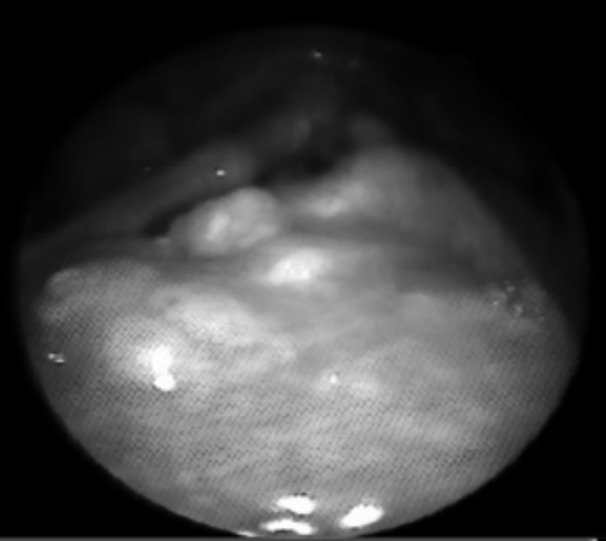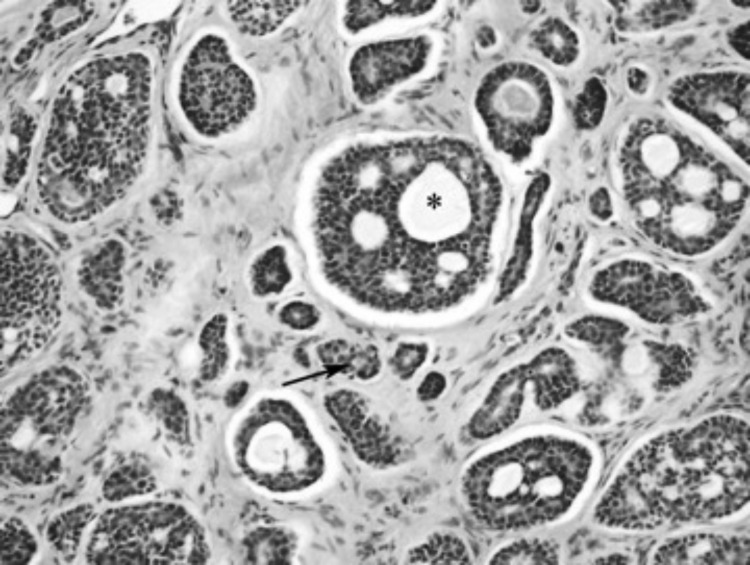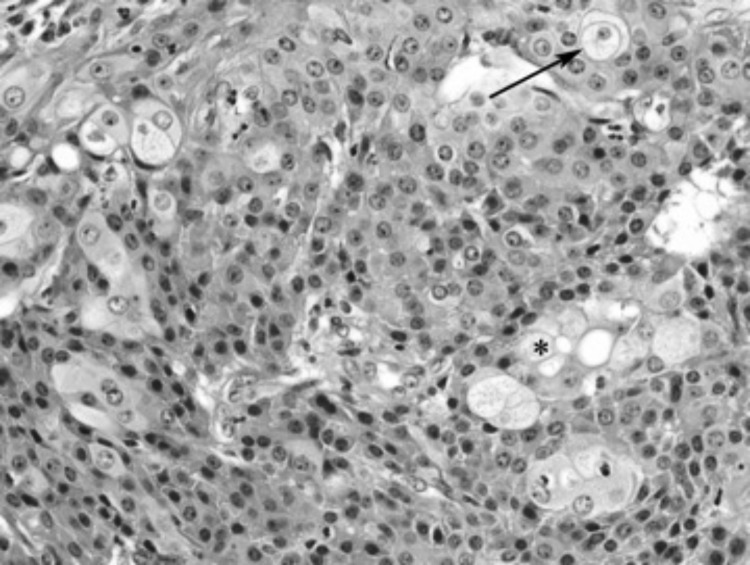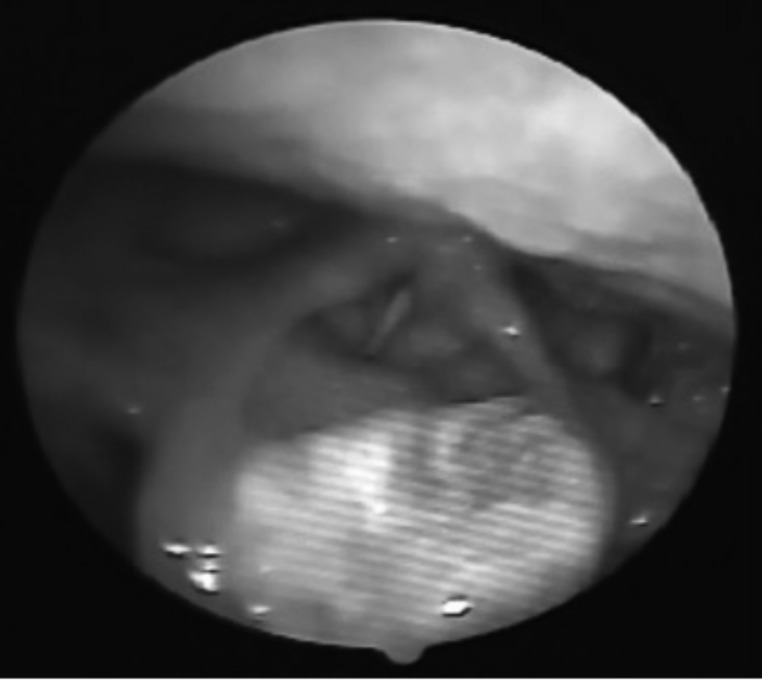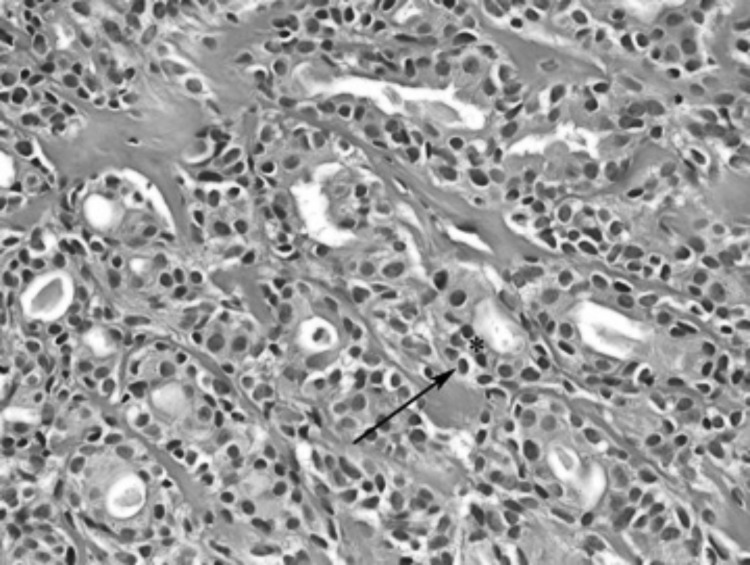SUMMARY
Malignant salivary gland tumours of the larynx are very rare, with limited reports of clinical outcomes. We present the decade-long experience of a single institution. A 10-year retrospective chart review of a tertiary head and neck cancer centre was performed. Index patients were identified from a review of a pathology database, and reviewed by a head and neck pathologist. Patient demographics, presenting signs and symptoms, treatment modalities and clinical outcomes were extracted from electronic medical records. Six patients were included, with an age range of 44 to 69. All six had malignant laryngeal salivary gland tumours. Pathologies included: three adenoid cystic carcinoma (2 supraglottic, 1 subglottic), one mucoepidermoid carcinoma (supraglottic), one epithelial-myoepithelial carcinoma (supraglottic) and one adenocarcinoma (transglottic). All were treated with surgery (2 endolaryngeal, 4 open) and five of six with the addition of adjuvant therapy (4 radiotherapy, 1 concurrent chemoradiation). One patient had smoking history; no patients had significant alcohol history. With 4.5 years of median follow-up, none of the patients has had recurrence or local/distant metastasis. Salivary gland tumours of the larynx present in mid to late-age, and can be successfully managed with a multi-modality approach, resulting in excellent local and regional control rates.
KEY WORDS: Larynx, Cancer, Salivary, Chemotherapy, Surgery, Partial laryngectomy
RIASSUNTO
I tumori a istotipo salivare della laringe sono molto rari, con pochi report in letteratura in merito al loro andamento clinico. Nel presente manoscritto discutiamo un'esperienza di 10 anni presso una singola struttura. Abbiamo condotto una review retrospettiva della casistica di un centro di oncologia della testa e del collo di terzo livello. I pazienti sono stati individuati mediante analisi di un database e sono stati revisionati da un Anatomo Patologo testa collo. I dati inerenti la clinica, le modalità di trattamento e gli esiti sono stati prelevati da archivi elettronici. Sono stati inclusi sei pazienti nello studio, con un range di età dai 44 ai 69 anni. Tutti e sei erano affetti da neoplasie maligne a istotipo salivare della laringe. Gli istotipi includevano: tre carcinomi adenoido-cistici (2 sopraglottico, 1 sottoglottico), un carcinoma mucoepidermoidale (sopraglottico), un carcinoma epiteliale-mioepiteliale (sopraglottico), e un adenocarcinoma (transglottico). Tutti sono stati sottoposti a trattamento chirurgico (2 chirurgie laser, 4 open) e 5 dei 6 pazienti sono stati successivamente sottoposti a terapia adjuvante (4 a radioterapia, 1 a radio-chemioterapia concomitante). Un paziente era fumatore; nessun paziente aveva storia di abuso di alcolici. A un follow-up con mediana di 4,5 anni nessuno dei pazienti ha presentato recidiva o metastasi locali o a distanza. I tumori a istotipo salivare della laringe si presentano solitamente in pazienti della seconda/terza età, e possono essere trattati con successo mediante approcci multimodali, con un ottimo controllo locoregionale di malattia.
Introduction
Malignant salivary gland tumours of the larynx are very rare neoplasms, which account for < 1% of all laryngeal malignancies 1. The most common malignant minor salivary gland tumours are adenoid cystic (32-69%) and mucoepidermoid carcinomas (15-35%) 2; adenocarcinomas are less frequent, and epithelial-myoepithelial carcinomas are even more rare 3. Unlike squamous cell carcinoma, which is strongly associated with inhaled tobacco use, malignant salivary tumours in the larynx have no strong association with smoking and appear to occur equally in both sexes. These tumours arise from subepithelial mucous glands in the larynx, which are found most commonly in the subglottis and supraglottis 4. In the true glottis, the possible areas of origin are floor of the ventricle and below the anterior commissure in the subglottis. Because these tumours do not arise on the free edge of the true vocal folds which are covered with thin squamous epithelium, there is often no voice change to detect these tumours at an early stage. They typically present in a subepithelial fashion, and can grow to a large size before they present with dysphonia or airway symptoms.
The aim of this study is to present our experience over the last decade with these rare tumours to provide insight into the multimodality treatment that is typically required for long-term oncologic success.
Materials and methods
In an IRB-approval protocol, the pathology archives of the Johns Hopkins Hospital and clinical records of patients with laryngeal cancer were reviewed to identify patients with malignant salivary gland laryngeal lesions between January 2004 and December 2013. Age, gender, presenting symptoms, location of the tumour, pathology, TNM classifications, treatment modality (surgery and/ or chemo radiotherapy) and disease status was extracted from patient charts.
Results
Six patients (3M, 3F) were included, with an age at diagnosis range of 44 to 69 (mean: 56 years). Pathologic classifications are summarised in Table I and included: three adenoid cystic carcinomas, one mucoepidermoid carcinoma, one epithelial-myoepithelial carcinoma and one adenocarcinoma, not otherwise specified. The most common presenting symptom was dysphonia. Half of patients presented with advanced stage disease, but all except the adenocarcinoma presented without regional or distant metastases. Only one patient was a smoker (T4 subglottic adenoid cystic carcinoma).
Table I.
Patient demographics and tumour characteristics, treatments and uutcomes.
| Case | Age | Gender | Histology | Primary Site | Stage | Tobacco | Clinical presentation | Surgical management | Approach | Surgical margins |
Adjuvant therapy | Laryngeal preservation |
Follow-up period | Outcome |
|---|---|---|---|---|---|---|---|---|---|---|---|---|---|---|
| 1 | 61 | F | Adenoid cystic carcinoma |
Supraglottis İnfrahyoid epiglottis |
T1N0M0 | N | Dysphagia | Supraglottic Laryngectomy |
Open | - | RT | Y | 3 y | ANED |
| 2 | 44 | M | Adenoid cystic carcinoma |
Supraglottis İnfrahyoid epiglottis |
T3N0M0 | N | Dysphonia | Supraglottic Laryngectomy |
Open | - | RT | Y | 13 m | ANED |
| 3 | 57 | F | Adenoid cystic carcinoma |
Subglottis | T4N0M0 | Y | Hemoptysis | TL + İpsilateral ND |
Open | - | RT | N | 14 y | ANED |
| 4 | 69 | M | Muco epidermoid carcinoma |
Supraglottis İntraarytenoid |
T1N0M0 | N | Dysphonia | Partial Laryngectomy |
Laser Endoscopic | - | RT | Y | 4.5 y | ANED |
| 5 | 58 | F | Epithelialmyoepitheial carcinoma |
Supraglottis suprahyoidepiglottis |
T1N0M0 | N | Cough | Supraglottic Laryngectomy |
Laser Endoscopic | - | None | Y | 6 y | ANED |
| 6 | 47 | M | Adenocarcinoma | Transglottic | T4N2cM0 | N | Dysphonia | TL + Bilateral Selective ND, Levels 1-5 |
Open | - | RT / CT | N | 11.5 y | ANED |
TL-Total laryngectomy; ND- Neck dissection; RT- Radiation therapy; CT- Chemotherapy; ANED- Alive with no evidence of disease
Treatment modalities and oncologic results are summarised in Table I. All patients were treated primarily with surgery, and negative surgical margins were obtained in all cases. The type of surgical approach varied with each case, but two were successfully managed with endolaryngeal surgery, while four required an open surgical approach. All but one patient underwent additional adjuvant therapy regardless of pathologic type or surgical margins (4 radiotherapy, 1 concurrent chemoradiation). After 4.5 years of median follow-up, none of the patients has had recurrence or local/distant metastasis. To highlight the unique presentation and management of these cases, three case studies with pathologic images are presented below.
Representative cases
Case two: A 44-year-old male professor presented with dysphonia lasting two years. He denied any difficulty swallowing; however, he had a significant amount of coughing while eating. On fiberoptic laryngoscopy a laryngeal mass on the epiglottis was identified with normal vocal fold mobility (Fig. 1), and a staging CT scan demonstrated a large bulky supraglottic lesion on the laryngeal surface of the epiglottis from the tip to the petiole, extending into the preepiglottic space, with fat planes preserved along the hyoid bone. Direct laryngoscopy and biopsy was performed. The lesion was consistent with adenoid cystic carcinoma with both tubular and cribriform histology (Fig. 2).
Fig. 1.
Flexible laryngoscopy showing a large mass of the epiglottis that did not impair vocal fold mobility, but did cause dysphonia through a mass effect on the supraglottic.
Fig. 2.
This case of adenoid cystic carcinoma consists of tubules and cribriform collections of cells with minimal cytoplasm and hyperchromatic, angulated nuclei. Prominent false ducts (asterisk) and subtle true ducts (arrow) are present, as is classic for this tumour type.
With these findings, he underwent an open supraglottic laryngectomy. The final pathology demonstrated adenoid cystic carcinoma with perineural invasion and no definitive venous/lymphatic invasion and extensive involvement of the paraglottic space, staging the tumour as T3. Surgery was followed by post-operative adjuvant radiation therapy. At latest follow-up, 1.5 years after surgery, he was free of disease.
Case four: A 69-year-old man presented with hoarseness and a history of slow and progressive voice change in the last 2 months. He denied pain, bleeding, cough, dysphagia, or otalgia. He was a non-smoker but had persistent gastro-oesophageal reflux. A suspicious mass was noted in the posterior commissure of the larynx on flexible laryngoscopy, and biopsy revealed a mucoepidermoid carcinoma in the larynx. He was then referred to our centre for management.
The lesion was centred in the posterior commissure, directly between the arytenoids, approximately 1 cm in maximum diameter. A preoperative MRI of the neck revealed a fullness of the posterior commissure with no well-defined mass, and no pathological cervical lymphadenopathy. The lesion was therefore completely excised endoscopically, using sharp instrumentation and a tissue shaver. Final pathology demonstrated 'intermediate grade mucoepidermoid carcinoma' (Fig. 3). All surgical margins were negative and post-operative radiation was used as adjuvant treatment. On last follow-up, 8 years after treatment, there was no evidence of disease.
Fig. 3.
Mucoepidermoid carcinoma consists of variable numbers of squamoid cells, mucous cells and intermediate cells. This laryngeal intermediategrade mucoepidermoid carcinoma consists primarily of uniform intermediate cells with abundant eosinophilic cytoplasm, with focal mucous cells (asterisk) and squamoid cells (arrow).
Case five: A 55-year-old woman complained of persistent cough of one year duration. She had presented one year prior for the same complaint and was noted at that time to have a small, benign appearing lesion of the epiglottis, which was diagnosed as presumptive epiglottic cyst. A chest x- ray performed as part of her work-up revealed non-small cell lung carcinoma, for which she received chemotherapy with etoposide and cisplatin, radiation, and left lobectomy with mediastinal and hilar lymph node dissection. Despite treatment for lung cancer, her cough and throat irritation persisted and she therefore represented to clinic. She was a life-long non-smoker.
On flexible examination, the mass on the epiglottis was demonstrated again and was larger in size (Fig. 4). Therefore, endoscopic biopsy and excision of the mass was performed with CO2 laser. The lesion was centred on the laryngeal surface of the epiglottis and completely excised to normal-appearing margins. The pathology of the lesion returned as epithelial-myoepithelial carcinoma of the epiglottis (Fig. 5), with tumour extending to multiple cauterised specimen edges. Therefore, two months later, she underwent a repeat suspension microlaryngoscopy and CO2 laser excision of epiglottis with all final margins negative for tumour. She has been regularly followed up for 6 years, and has no evidence of disease.
Fig. 4.
Flexible laryngoscopy demonstrating an ulcerative mass on the laryngeal surface of the epiglottis with normal vocal fold mobility.
Fig. 5.
This case of laryngeal epithelial-myoepithelial carcinoma was biphasic, with an inner layer of ductal cells (asterisk) tightly coupled with an outer layer of myoepithelial cells with clear cytoplasm (arrow).
Discussion
In the larynx, salivary glands have a distinct anatomic distribution 4, and occur mainly in the subglottis and supraglottis. Relative rates of salivary malignancies for these subsites differ by series 2 5, but true vocal cord involvement is rarely reported. This is in contradistinction to squamous cell carcinoma, which most commonly originates in the squamous epithelium covering the true vocal folds, and explains the difference in presenting symptoms and stage 6. Most of our cases (67%) had supraglottic tumours and therefore the most common presenting symptom was hoarseness, dysphagia and cough. It is interesting to note that the supraglottic tumours in our series mimic the patterns of spread seen in traditional squamous cell carcinoma – invasion in the preepiglottic but not to the true vocal cord, allowing for laryngeal preservation surgery. This suggests that the barriers to tumour spread within the larynx, such as the quadrangular membrane and conus elasticus, are resistant to tumours of all histologies. As in most other series, we report a male to female ratio of 1:1 1 2 7 8, with a minority of patients having a history of smoking 2.
The predominant pathologic diagnosis in the literature is adenoid cystic carcinoma, consistent with the 50% rate reported in our series 2 5. In the early stages, salivary gland tumours may not present with any symptoms due to slow submucosal spread. Two of three adenoid cystic carcinoma cases were diagnosed as T3 and T4 tumours. One of these patients had perineural invasion. There are no standardised therapeutic decisions with prospective studies due to the rarity and different histopathological types. Tumour type, grade, location and symptoms should be taken into consideration while choosing treatment options. Postoperative radiotherapy is widely accepted as adjuvant modality, especially in cases with a high-grade tumour, unclear or positive margins, and perineural spread 8-12. All three patients in our series with adenoid cystic carcinomas had adjuvant radiotherapy and none had recurrence. Nodal disease was not present in any patient in our study, and a low rate of nodal disease is consistent with previously published reports 1.
One of our patients had supraglottic mucoepidermoid carcinoma. About 60% of patients with mucoepidermoid carcinomas of the larynx are localised in the supraglottic area 13. In patients with high-grade mucoepidermoid carcinomas, neck dissections have been suggested regardless of clinical nodal status 13; others conclude that neck dissections are not indicated in salivary gland tumours of the larynx unless nodal metastasis is clinically apparent 1 2 7 8. Radiotherapy is also recommended in high-grade cases because of the high incidence of local recurrence 14. Our patient underwent endoscopic excision, and given the patient's intermediate grade pathology he also underwent adjuvant radiation therapy.
The most common site of epithelial-myoepithelial carcinoma (EMC) is the parotid gland or submandibular gland. EMC of the larynx is very rare. Only four cases have been previously reported in the literature to date 3 15-17; one of them being the present case 15. Information about demographics, treatment and prognosis of EMC in the larynx is scarce because of its rarity and there is no consensus for management. In our case, long-term disease control was achieved with surgical excision, but as highlighted in the case presentation, submucosal spread and an unusual pathology has the potential to create diagnostic uncertainty and inadequate initial resection if the surgeon is anticipating a benign pathology. Therefore, our case required reresection to achieve negative margins after final pathology from the surgical specimen revealed EMC and positive margins.
Finally, one patient in the current series presented with advanced adenocarcinoma, not otherwise specified (NOS) with significant local and nodal disease. Only 0.35% to 0.5% of all laryngeal malignancies are adenocarcinomas NOS, and are mostly seen in males 18, as in our case. Adenocarcinomas NOS of the larynx tend to metastasise to both regional and distant site 19-21 and therefore require aggressive surgical management and adjuvant therapy. Our patient did not have any recurrence or metastasis after total laryngectomy and adjuvant chemoradiotherapy after a follow-up of 11.5 years.
Careful long-term follow-up for laryngeal salivary tumours is critical. Distant metastases to the lung is a hallmark of adenoid cystic carcinoma and long-term follow up is mandatory, since recurrences may occur after more than 10 years after primary treatment 2 8 12 22. Nevertheless, adjuvant therapy may have a role in achieving long-term disease control, as the majority of our patients received adjuvant treatment and none had recurrences and/or local or distal metastasis after a median follow-up of 4.5 years.
Conclusions
Salivary gland malignancies are rare tumours of the larynx that present in mid- to late-age, and can be successfully managed with a multi-modality approach, resulting in excellent local and regional control rates.
Footnotes
This work was presented at the 10th Congress of the European Laryngology Society, April 9-12, 2014, Antalya, Turkey.
References
- 1.Batsakis JG, Luna MA, El-Naggar AK. Nonsquamous carcinomas of the larynx. Ann Otol Rhinol Laryngol. 1992;101:1024–1026. doi: 10.1177/000348949210101212. [DOI] [PubMed] [Google Scholar]
- 2.Ganly I, Patel SG, Coleman M, et al. Malignant minor salivary gland tumors of the larynx. Arch Otolaryngol Head Neck Surg. 2006;132:767–770. doi: 10.1001/archotol.132.7.767. [DOI] [PubMed] [Google Scholar]
- 3.Moukarbel RV, Kwan K, Fung K. Laryngeal epithelial-myoepithelial carcinoma treated with partial laryngectomy. J Otolaryngol Head Neck Surg. 2010;39:E39–E41. [PubMed] [Google Scholar]
- 4.Bak-Pedersen K, Nielsen KO. Subepithelial mucous glands in the adult human larynx. Studies on number, distribution and density. Acta Otolaryngol. 1986;102:341–352. doi: 10.3109/00016488609108685. [DOI] [PubMed] [Google Scholar]
- 5.Nielsen TK, Bjørndal K, Krogdahl A, et al. Salivary gland carcinomas of the larynx: a national study in Denmark. Auris Nasus Larynx. 2012;39:611–614. doi: 10.1016/j.anl.2012.02.003. [DOI] [PubMed] [Google Scholar]
- 6.Levine HL, Tubbs R. Nonsquamous neoplasms of the larynx. Otolaryngol Clin North Am. 1986;19:475–488. [PubMed] [Google Scholar]
- 7.Veivers D, Vito A, Luna-Ortiz K, et al. Supracricoid partial laryngectomy for non-squamous cell carcinoma of the larynx. J Laryngol Otol. 2001;115:388–392. doi: 10.1258/0022215011907947. [DOI] [PubMed] [Google Scholar]
- 8.Del Negro A, Ichihara E, Tincani AJ, et al. Laryngeal adenoid cystic carcinoma: case report. Sao Paulo Med J. 2007;125:295–296. doi: 10.1590/S1516-31802007000500010. [DOI] [PMC free article] [PubMed] [Google Scholar]
- 9.Wang MC, Liu CY, Li WY, et al. Salivary gland carcinoma of the larynx. J Chin Med Assoc. 2006;69:322–325. doi: 10.1016/S1726-4901(09)70266-7. [DOI] [PubMed] [Google Scholar]
- 10.Zvrko E, Golubović M. Laryngeal adenoid cystic carcinoma. ActaOtorhinolaryngol Ital. 2009;29:279–282. [PMC free article] [PubMed] [Google Scholar]
- 11.Calis AB, Coskun BU, Seven H, et al. Laryngeal mucoepidermoid carcinoma: report of two cases. Auris Nasus Larynx. 2006;33:211–214. doi: 10.1016/j.anl.2005.11.005. [DOI] [PubMed] [Google Scholar]
- 12.Tincani AJ, Del Negro A, Araújo PP, et al. Management of salivary gland adenoid cystic carcinoma: institutional experience of a case series. Sao Paulo Med J. 2006;124:26–30. doi: 10.1590/S1516-31802006000100006. [DOI] [PMC free article] [PubMed] [Google Scholar]
- 13.Prgomet D, Bilić M, Bumber Z, et al. Mucoepidermoid carcinoma of the larynx: report of three cases. J Laryngol Otol. 2003;117:998–1000. doi: 10.1258/002221503322683957. [DOI] [PubMed] [Google Scholar]
- 14.Gomes V, Costarelli L, Cimino G, et al. Mucoepidermoid carcinoma of the larynx. Eur Arch Otorhinolaryngol. 1990;248:31–34. doi: 10.1007/BF00634778. [DOI] [PubMed] [Google Scholar]
- 15.Visaya JM, Chu EA, Schmieg J, et al. Pathology quiz case 1. Epithelial-myoepithelial carcinoma (EMC) Arch Otolaryngol Head Neck Surg. 2009;135:832–832. doi: 10.1001/archoto.2009.82-a. [DOI] [PubMed] [Google Scholar]
- 16.Mikaelian DO, Contrucci RB, Batsakis JG. Epithelial-myoepithelial carcinoma of the subglottic region: a case presentation and review of the literature. Otolaryngol Head Neck Surg. 1986;95:104–106. doi: 10.1177/019459988609500120. [DOI] [PubMed] [Google Scholar]
- 17.Yan Y, Wang L, Ke J, Sun S, et al. Diagnosis and treatment of nonsquamous cell neoplasms located in subglottis. Lin Chung Er Bi Yan Hou Tou Jing Wai Ke Za Zhi. 2014;28:182–185. [PubMed] [Google Scholar]
- 18.Ebru T, Omer Y, Fulya OP, et al. Primary mucinous adenocarcinoma of the larynx in female patient: a rare entity. Ann Diagn Pathol. 2012;16:402–406. doi: 10.1016/j.anndiagpath.2011.03.006. [DOI] [PubMed] [Google Scholar]
- 19.Haberman PJ, Haberman RS. Laryngeal adenocarcinoma, not otherwise specified, treated with carbon dioxide laser excision and postoperative radiotherapy. Ann Otol Rhinol Laryngol. 1992;101:920–924. doi: 10.1177/000348949210101107. [DOI] [PubMed] [Google Scholar]
- 20.Fechner RE. Adenocarcinoma of the larynx. Can J Otolaryngol. 1975;4:284–289. [PubMed] [Google Scholar]
- 21.Hilger AW, Prichard AJ, Jones T. Adenocarcinoma of the larynx-- a distant metastasis from a rectal primary. J Laryngol Otol. 1998;112:199–201. doi: 10.1017/s0022215100140319. [DOI] [PubMed] [Google Scholar]
- 22.Monin DL, Sparano A, Litzky LA, et al. Low-grade mucoepidermoid carcinoma of the subglottis treated with organpreservation surgery. Ear Nose Throat J. 2006;85:332–336. [PubMed] [Google Scholar]



